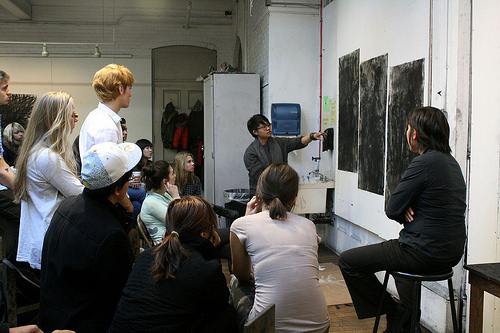Ask the Art Professor: Who should you make art for, yourself or your professor?
Welcome to “Ask the Art Professor“! Essentially an advice column for visual artists, this is your chance to ask me your questions about being an artist, the creative process, career advice, a technical question about a material, etc. Anything from the smallest technical question to the large and philosophical is welcome. I’ll do my best to provide a thorough, comprehensive answer to your question. Submit your question by emailing me at clara(at)claralieu.com, or by posting here on this blog. All questions will be posted anonymously. Read an archive of past articles here.
Here’s today’s question:
“Since art is so subjective, students often like to execute their pieces for their own preference, which may not necessarily be something that impresses the professor. Students don’t mind it because nevertheless, they make the pieces and therefore they should make it “for” themselves not “for” the professor. Is it wrong to think that way?”
I’ve always believed that as a student, one should never try to make artwork that is “for” the professor. When you’re in school, there’s no reason to restrict yourself in such a way, and doing so will hold you back tremendously in terms of the kind of progress you’ll be able to make.
Having been on both sides of the fence, I can understand where the tendency to please the professor comes from for many students. After all, who doesn’t want to get a positive critique from their professor on their artwork? It would seem that the quickest, most straightforward way to get a good critique is to figure out what type of artwork your professor likes, and then do that. On the contrary, this strategy often times backfires. Not only is it impossible to predict what your professor will like, but you will almost always end up making work that you have no interest in. It’s essentially a losing situation from all ends.
Professors will respect you for having your own ideas and for making artwork that has its own sense of purpose, even if it’s in complete contradiction to their personal taste and aesthetics. A good professor will know to keep their personal biases out of the critique and to evaluate the work objectively. Many of my students have commented to me in the past that once they stopped trying to please me, their experience and their artwork instantly got better. You have to create the artwork that you want to make, not what you think someone else wants to see. Everyone has their own personal list of reasons for why they make artwork, and pleasing their professor should be not be on that list.
When you get out of school and you start to work professionally for a specific client, that is the situation where it is absolutely necessary to please a single individual. I was a portrait painter at the beginning of my career, and nothing mattered except the happiness of the client. I had to do whatever it took to keep them happy, even if it meant doing what I saw as a creative compromise in the artwork. If they asked for it, I had to do it. And half the time, the clients themselves don’t even know what they wanted, all they ever seemed to know was what they didn’t want. Once I was told that the pink cheeks on a portrait were too bright. I toned down the pink ever so slightly to fix it, and was then told it looked too pale. You’ll have more than enough opportunities to please others in the future, so take advantage of every situation you have to make work for yourself.
Related articles:
“What is the purpose of a degree in fine art?”
“What should you include in an art portfolio for art school or college?”
“When you have a fine arts degree, what do you do for the rest of your life?”
“How do you preserve your artistic integrity within the strict time limitations in an academic setting?”
“Is art education really so popular in western countries?”
“What do you do after you’ve finished formalized training?”
“Should art students study abroad even if it distracts from job preparation?”






